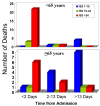Polytrauma in the elderly: predictors of the cause and time of death
- PMID: 20465806
- PMCID: PMC2880283
- DOI: 10.1186/1757-7241-18-26
Polytrauma in the elderly: predictors of the cause and time of death
Abstract
Background: Increasing age and significant pre-existing medical conditions (PMCs) are independent risk factors associated with increased mortality after trauma. Our aim was to review all trauma deaths, identifying the cause and the relation to time from injury, ISS, age and PMCs.
Methods: A retrospective analysis of trauma deaths over a 6-year period at the study centre was conducted. Information was obtained from the Trauma Audit and Research Network (TARN) dataset, hospital records, death certificates and post-mortem reports. The time and cause of death, ISS, PMCs were analysed for two age groups (<65 years and >or= 65 years).
Results: Patients >or= 65 years old were at an increased risk of death (OR 6.4, 95% CI 5.2-7.8, p < 0.001). Thirty-two patients with an ISS of >15 and died within the first 24 hours of admission, irrespective of age, from causes directly related to their injuries. Twelve patients with an ISS of <16, died after 13 days of medical conditions not directly related to their injuries (p = 0.01). Thirty four patients had significant PMCs, of which 11 were <65 years (34.4% of that age group) and 23 were >or= 65 years (95.8% of that age group) (p = 0.02). The risk of dying late after sustaining minor trauma (ISS <16) is increased if a PMC exists (OR 5.5, p = 0.004).
Conclusion: Elderly patients with minor injuries and PMCs have an increased risk of death relative to their younger counterparts and are more likely to die of medical complications late in their hospital admission.
Figures
References
-
- Office of national statistics. http://www.statistics.gov.uk/cci/nugget.asp?id=949 date last accessed 17th April 2010.
-
- MacKenzie EJ, Morris JA, Smith GS, Fahey M. Acute hospital costs of trauma in the United States: implications for regionalized systems of care. Journal of Trauma. 1990;30:1096–103. - PubMed
-
- Griffiths C, Wright O, Rooney C. Trends in injury and poisoning mortality using the ICE on injures statistics matrix, England and Wales, 1979-2004. Office for National Statistics. 2006. pp. 1–14. - PubMed
MeSH terms
LinkOut - more resources
Full Text Sources




